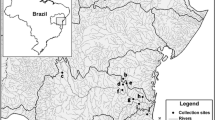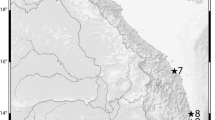Abstract
DNA barcoding has shown high efficiency in taxonomy disentanglement. However, barcode clusters do not necessarily reflect independent biological species. Herein, Protapes clams in seas of the south China were used as a case study to illustrate how additional lines of evidences confirm the species status of cryptic species uncovered in barcoding studies. Species boundaries within Protapes were delimited iteratively using six gene fragments under both distance-based and phylogeny-based approaches. Our results showed that species candidates within Paphia (Protapes) gallus complex are independent biological species, and two hidden species also exist within P. (P.) sinuosa. Our results double the number of species of Protapes in the western Pacific, suggesting its biodiversity in this region might be severely underestimated. The present study shows that combining DNA barcoding with subsequent multiple-line analyses is effective in species-level biodiversity exploration.



Similar content being viewed by others
References
Chen J, Li Q, Kong L, Yu H (2011a) How DNA barcodes complement taxonomy and explore species diversity: the case study of a poorly understood marine fauna. PLoS ONE 6:e21326
Chen J, Li Q, Kong L, Zheng X (2011b) Molecular phylogeny of venus clams (Mollusca, Bivalvia, Veneridae) with emphasis on the systematic position of taxa along the coast of mainland China. Zool Scr 40:260–271
Colgan DJ, Ponder WF, Eggler PE (2000) Gastropod evolutionary rates and phylogenetic relationships assessed using partial 28S rDNA and histone H3 sequences. Zool Scr 29:29–63
Giribet G, Carranza S, Bagua J, Ruitort M, Ribera C (1996) First molecular evidence for the existence of a Tardigrada + Arthropoda clade. Mol Biol Evol 13:76–84
Guindon S, Gascuel O (2003) A simple, fast, and accurate algorithm to estimate large phylogenies by maximum likelihood. Syst Biol 52:696–704
Hassouna N, Michot B, Bachellerie JP (1984) The complete nucleotide sequence of mouse 28S rRNA gene. implications for the process of size increase of the large subunit rRNA in higher eukaryotes. Nucleic Acids Res 12:3563–3583
Hebert PDN, Cywinska A, Ball SL, deWaard JR (2003) Biological identifications through DNA barcodes. Proc R Soc B 270:313–332
Huson DH, Bryant D (2006) Application of phylogenetic networks in evolutionary studies. Mol Biol Evol 23:254–267
Kappner I, Bieler R (2006) Phylogeny of venus clams (Bivalvia: Venerinae) as inferred from nuclear and mitochondrial gene sequences. Mol Phylogenet Evol 40:317–331
Kimura M (1980) A simple method of estimating evolutionary rate of base substitutions through comparative studies of nucleotide sequences. J Mol Evol 16:111–120
Lefébure T, Douady CJ, Gouy M, Gibert J (2006) Relationship between morphological taxonomy and molecular divergence within Crustacea: proposal of a molecular threshold to help species delimitation. Mol Phylogenet Evol 40:435–447
Matsukuma A, Ozawa T, Yoosukh W (1988) Paphia (Protapes) irrediviva Makiyama, an extinct tropical embayment element of Japanese Genozoci mollusks, and allied species from the Indo-West Pacific. Saito Ho-on Kai Spec Pub (Prof T Kotaka Commem Vol) 405–415
Meier R, Kwong S, Vaidya G, Ng PKL (2006) DNA barcoding and taxonomy in Diptera: a tale of high intraspecific variability and low identification success. Syst Biol 55:715–728
Meyer CP, Paulay G (2005) DNA barcoding: error rates based on comprehensive sampling. PLoS Biol 3:e422
Morando M, Avila LJ, Sites JW (2003) Sampling strategies for delimiting species: genes, individuals, and populations in the Liolaemus elongatus-kriegi complex (Squamata: Liolaemidae) in Andean–Patagonian South America. Syst Biol 52:159–185
Oliver PG, Glover E (1996) Paphia (Protapes) (Bivalvia, Veneroidea) in the Arabian sea, with the description of a new species. J Conchol, Lond 35:389–405
Posada D (2008) jModelTest: phylogenetic model averaging. Mol Biol Evol 25:1253–1256
Ronquist F, Huelsenbeck JP (2003) MrBayes 3: Bayesian phylogenetic inference under mixed models. Bioinformatics 19:1572–1574
Rozas J, Sanchez-DelBarrio JC, Messeguer X, Rozas R (2003) DnaSP, DNA polymorphism analyses by the coalescent and other methods. Bioinformatics 19:2496–2497
Smith MA, Fisher BL, Hebert PDN (2005) DNA barcoding for effective biodiversity assessment of a hyperdiverse arthropod group: the ants of Madagascar. Philos Trans R Soc Lond B Biol Sci 360:1825–1834
Srivathsan A, Meier R (2011) On the inappropriate use of Kimura-2-parameter (K2P) divergences in the DNA-barcoding literature. Cladistics 27:490–528
Swofford DL (2003) PAUP*: phylogenetic analyses using parsimony (* and other methods). Version 4. Sinauer Associates, Sunderland
Tamura K, Peterson D, Peterson N, Stecher G, Nei M, Kumar S (2011) MEGA5: molecular evolutionary genetics analysis using maximum likelihood, evolutionary distance, and maximum parsimony methods. Mol Biol Evol 8:2731–2739
Torii H, Sato S, Hamaguchi M, Henmi Y, Yamashita H (2010) The comparison of shell morphology and genetic relationship between Meretrix lusoria and M. petechialis in Japan and Korea. Plankon Benthos Res 5:231–241
Wiens JJ (2007) Species delimitation: new approaches for discovering diversity. Syst Biol 56:875–878
Zhang JB, Hanner R (2011) DNA barcoding is a useful tool for the identification of marine fishes from Japan. Biochem Syst Ecol 39:31–42
Acknowledgments
This study was supported by the grants from National Natural Science Foundation of China (41276138, 31072207), and 973 Program (2010CB126406).
Author information
Authors and Affiliations
Corresponding author
Rights and permissions
About this article
Cite this article
Chen, J., Li, Q., Kong, L. et al. Additional lines of evidence provide new insights into species diversity of the Paphia subgenus Protapes (Mollusca, Bivalvia, Veneridae) in seas of south China. Mar Biodiv 44, 55–61 (2014). https://doi.org/10.1007/s12526-013-0184-1
Received:
Revised:
Accepted:
Published:
Issue Date:
DOI: https://doi.org/10.1007/s12526-013-0184-1




